
Locomotives on static display at the Bluebell
SR Maunsell S15-class No. 847
- Class: S15
- Wheels: 4-6-0
- Built: 1936
- Numbers Carried: 847, 30847
- Last Overhaul Completed: 11 Dec 2013
- Previously Operational: 13 Nov 1992 – 6 Oct 1997
- Last Operational: 5 December 2021
- Owned By: Maunsell Locomotive Society
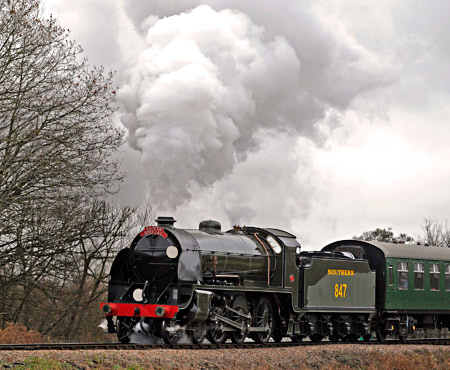)
This class of locomotives, of which this was the final locomotive to be built, were essentially a goods version of the King Arthur class of express passenger locos (N15). The S15s thus became known as Goods Arthurs, and like the N15s, their origins went back to the LSWR designs of Robert Urie. Coming to the Bluebell from Barry scrapyard in 1978, its restoration was not started until the Maunsell Society had completed the restoration of their Q-class locomotive in 1983.
The boiler received its hydraulic test in 1988, and although it did not enter service at that time, regulations retrospectively applied mean that the boiler certificate, valid for ten years, started ticking from that test. Hence after a relatively short spell (under 5 years) in traffic it was withdrawn for overhaul. The Maunsell Locomotive Society then carried out as much preparatory work for the boiler lift as is possible, whilst maintaining the loco in a presentable condition for display.
The overhaul commenced in earnest in October 2006, with some of funds to finance the overhaul (in the Bluebell’s own workshop) already available. The boiler overhaul, which was a major part of the project involving replacing many of the stays including the complex crown stays, was returned to the overhauled frames on 9 August 2013, and it re-entered service on 11 December that year.
Following a very successful 8 years in service, the locomotive will require further major firebox repairs, and the driving wheel tyres are now at scrapping size and will be replaced, at its next overhaul.
→ Find out more
→ The Maunsell Locomotive Society
→ Audio Recording of No. 847 in action
Dorking Greystone Lime Company, No. 3 ‘Captain Baxter’
- Wheels: 0-4-0T
- Built: 1877, Fletcher Jennings
- Last Overhaul Completed: August 2010
- Last Operational: 6 October 2018
- Current Status: Static display, awaiting overhaul
- Owned By: Bluebell Railway
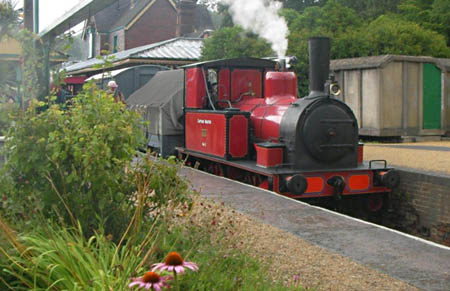)
‘Baxter’ arrived at the Bluebell in 1960 after spending its working life at the Dorking Greystone Lime Works at Betchworth station. It was only in 1982 that it returned to traffic after a comprehensive overhaul.
‘Baxter’ runs a very low mileage each year, so, having received a major mechanical overhaul in the early 1980s and a boiler overhaul ten years later, following the expiry of its boiler certificate in July 2000 it was not expected to take much effort to give it another ten-year certificate. However various items needed rather more work than expected, and the opportunity was also taken to fit steam heating and vacuum braking equipment for the first time. This work (reported here) has been undertaken by the volunteer team who undertook the overhaul of “Fenchurch”, and “Captain Baxter” (as it had been named until 1947) returned to service at the 50th Anniversary Gala in August 2010.
→ Find out more
→ Details of 2010 overhaul
→ Video clip of Baxter working the Vintage Goods train in September 1997 by Lewis Nodes
SECR Wainwright C-class, No. 592
- Class: C
- Wheels: 0-6-0
- Built: 1902
- Numbers Carried: 592, A592, 1592, 31592
- Last Overhaul Completed: 7 October 2007
- Last Operational: 13 May 2017
- Current Status: Static display, awaiting overhaul
- Owned By: The Bluebell Railway Trust
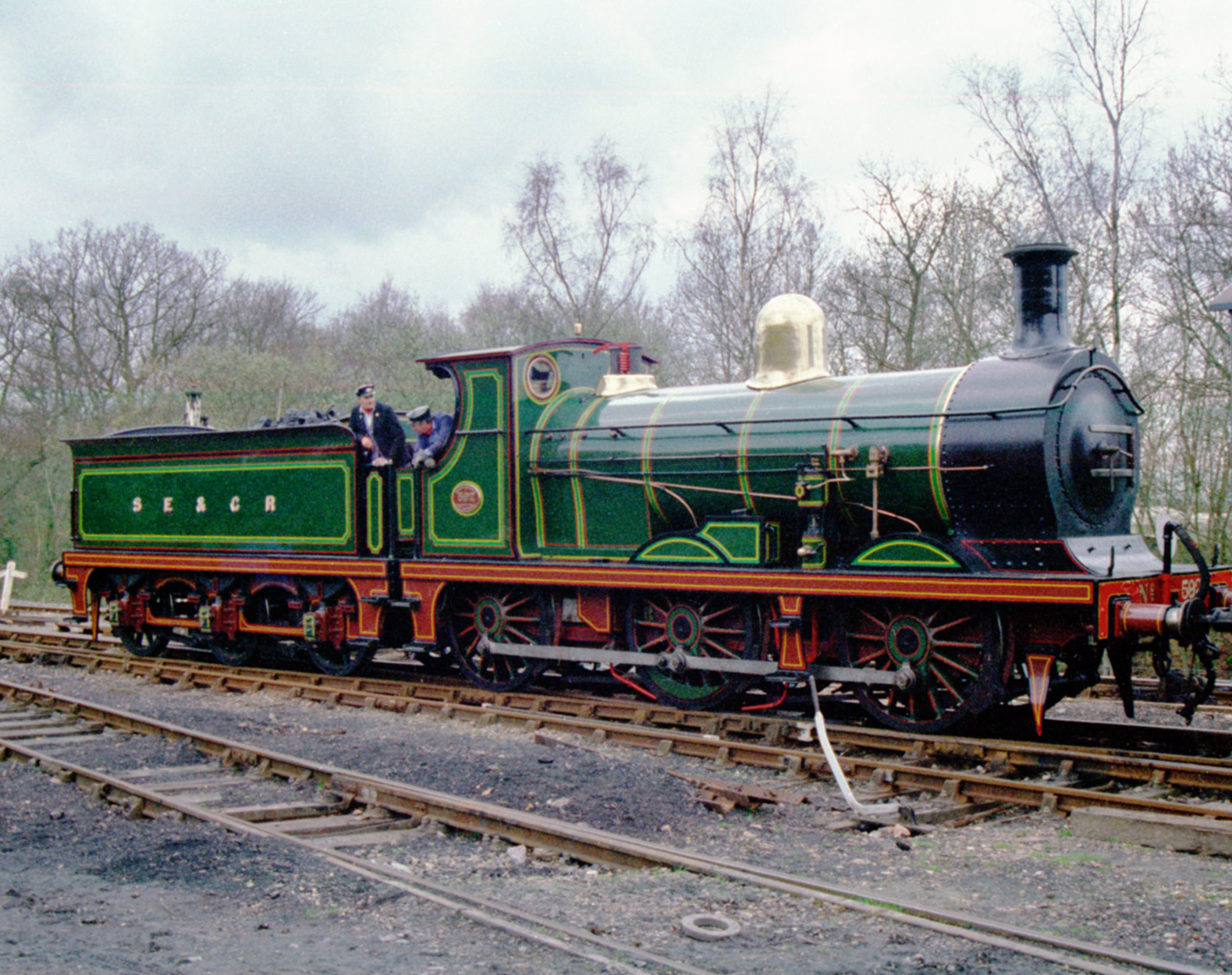)
After the amalgamation of the SER and the LCDR in 1899 it fell to Harry Wainwright to put some order into the locomotive designs the new company inherited. The C-class was his standard goods design, and served the SECR, and in turn the SR and BR, well. The steam powered reverser on this locomotive was most successful, and this design was to be found on goods and shunting engines built by the SECR and the SR for more than 40 years afterwards.
Preserved initially at Ashford Works by the Wainwright ‘C’ Preservation Society, it moved to the Bluebell in 1970, and finally entered service in 1975 after work on its boiler and a badly damaged axle journal. Its 1994 overhaul at the hands of volunteers saw it returned to service with a spare overhauled tender which we had been fortunate enough to obtain. In 2006-7 we overhauled the spare boiler which we have for this locomotive, since the firebox of the existing boiler was deemed beyond repair. Mechanically the locomotive was in reasonable order, although the condition of the cylinders was expected to determine how long it ran before its next overhaul. It returned to service on 8th October 2007, and it was known to require a new cylinder block at a subsequent overhaul, but advances in cylinder lining techniques led to the cylinder block being removed for a repair in late 2012, which, with further work on the valves, enabled a much stronger locomotive to re-enter service.
Now withdrawn from service pending its next overhaul, a replacement cylinder block has been cast, and will be fitted as part of that overhaul. In the interim, it is currently on display, with full footplate access, as part of our SteamWorks! interactive exhibition at Sheffield Park.
The locomotive was generously gifted to The Bluebell Railway Trust by the Wainwright ‘C’ Preservation Society on 20 September 2014.
LBSCR Billinton E4 Radial Tank, No. B473
- Class: E4
- Wheels: 0-6-2T
- Built: 1898
- Numbers Carried: 473 ‘Birch Grove’, B473, 2473, s2473, 32473
- Last Overhaul Completed: January 2010
- Last Operational: May 2016
- Current Status: Static display, awaiting overhaul
- Owned By: Bluebell Railway
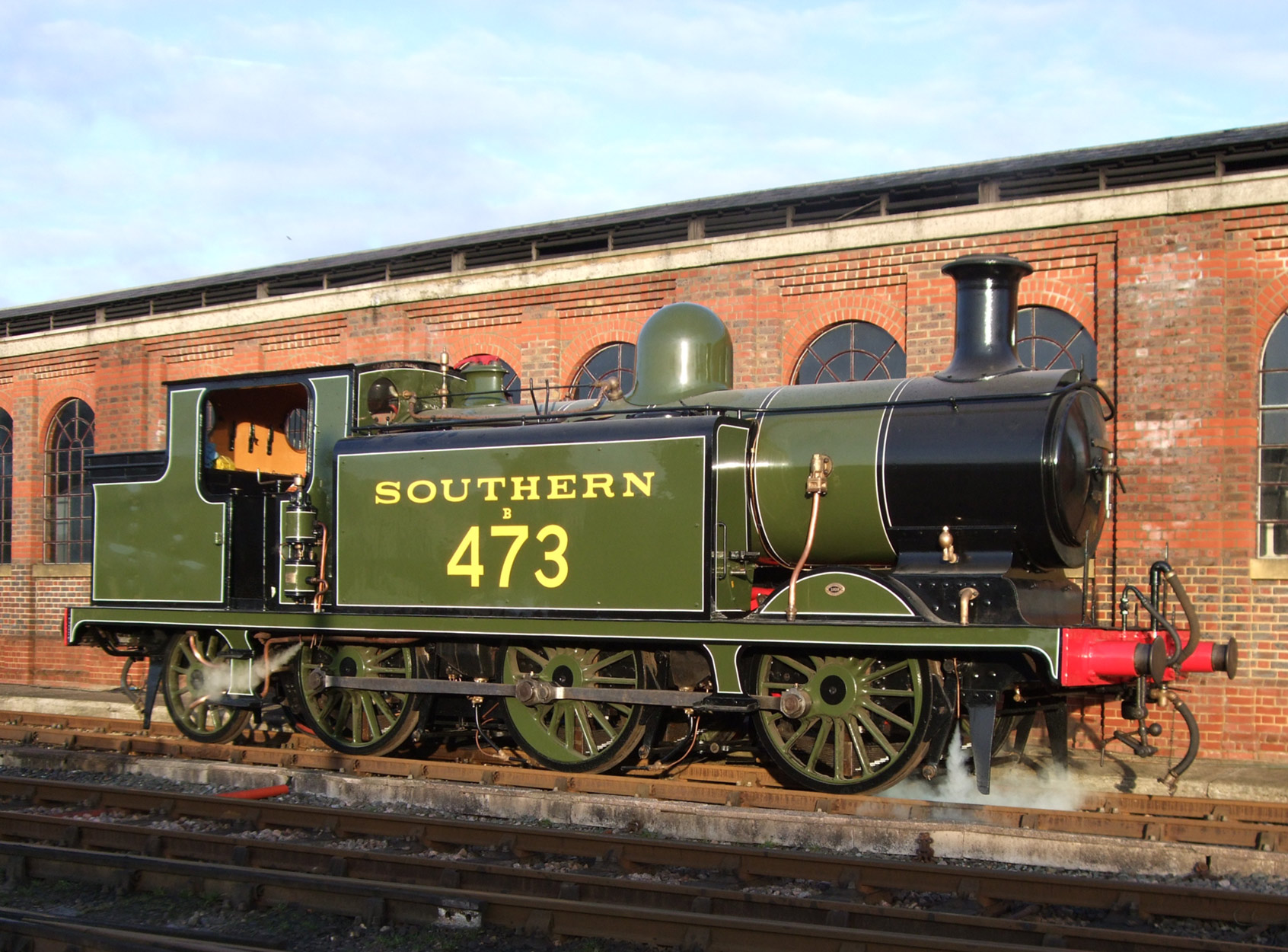)
The only surviving locomotive to a design by Robert Billinton, ‘Birch Grove’ is one of a family of locomotives known as Radial Tanks due to the radial axle beneath the cab. Mixed traffic locomotives, they were equally at home on local passenger workings as branch-line goods services. Although almost the oldest, the E4s were amongst the last of the Brighton Radials to survive.
‘Birch Grove’ itself was one of the first two Brighton locos to be repainted into Southern Railway livery, as B473, in February 1924. It was bought straight out of BR service in 1962 and served the Bluebell for a decade before being withdrawn for a protracted stop-go overhaul. It finally became operational again in 1998 thanks to a bequest which paid for the major boiler repairs required and a team of volunteers who undertook some of the easier boiler work and most of the remaining work, as is well recorded here.
Remarkably ‘Birch Grove’ retains her original boiler, number 891, fitted new in July 1898. It had been passed to various other Brighton tanks of classes D3, E3 and E4 before being refitted to Birch Grove in 1960.
It was repainted from LBSCR umber livery into BR lined black in February 2005, for a limited period – see photos. With a boiler still in good condition, its next overhaul was started immediately following the expiry of its boiler certificate in May 2008, and after a major rebuild of its cylinders, which was the most significant item of work required, it re-entered service in January 2010, carrying 1920s Southern Railway olive green livery, running until May 2016. At its next overhaul it will require major replacement of copper plates forming the inner firebox.
SR Maunsell U-class, No. 1638
- Class: U
- Wheels: 2-6-0
- Built: 1931
- Numbers Carried: A638, 1638, 31638
- Last Overhaul Completed: February 2006
- Last Operational: 4 July 2015
- Current Status: Static display, awaiting overhaul, on long-term loan to the Maunsell Locomotive Society
- Owned By: Bluebell Railway
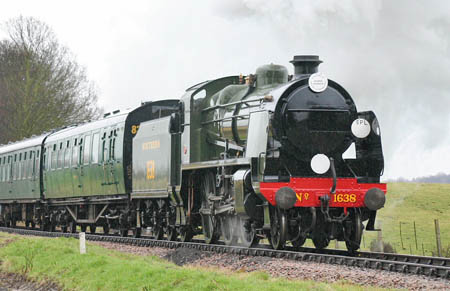)
One of two U-class locomotives on the Bluebell Railway, both coming via Barry scrapyard, this one was privately purchased and donated to the Bluebell. It has been placed on long-term loan to the Maunsell Locomotive Society, who also own 1618, and was their main restoration project for over a decade. Having lost its tender while at Barry, a new one has been built, starting from the remains of a snowplough which in turn had been created using a Schools class locomotive tender as its base. The loco steamed for the first time in preservation in February 2006.
It was always expected that the locomotive would need major work after about seven years of use, and indeed over the winter of 2012/13 a partial boiler-lift and some re-staying was undertaken, followed by further copper welding on the firebox later in 2013. It was not expected to remain in service for the whole of the remaining period of its “ten-year” ticket, and after a very good nine-and-a-half years bearing the brunt of our front-line services, with several relatively minor faults and a hydraulic boiler test required if repairs were carried out, it was decided, rather than committing workshop time and money to gain a few months extra on its boiler certificate, that it was sensible to use those resources in expediting the overhaul of ‘Camelot’.
→ Find out more
→ Details of 2006 overhaul
→ The Maunsell Locomotive Society
LBSCR Stroudley Terrier, No. 55 ‘Stepney’
- Class: A1X
- Wheels: 0-6-0T
- Built: 1875
- Numbers Carried: 55, 655, B655, 2655, 32655
- Last Overhaul Completed: May 2010
- Last Operational: 29 March 2014
- Current Status: Static display, awaiting major overhaul
- Owned By: Bluebell Railway
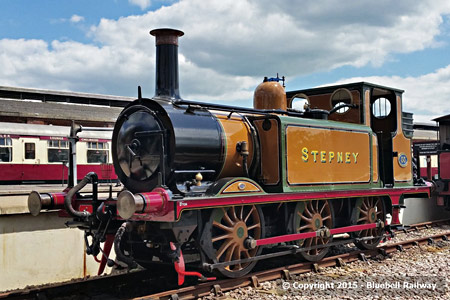)
Stroudley’s famous Terriers survived for decades after more modern designs had been scrapped, working on lightly laid branch lines. Here these diminutive engines were often the only engines light enough to cross some particular bridge. In later years ‘Stepney’ was particularly associated with the Hayling Island branch, until sold to the Bluebell Railway in May 1960 as our first locomotive.
Repainted into Stroudley’s famous “Improved Engine Green” gamboge livery, it has been a favourite of many children, and some of those children are now introducing their own children to “Stepney the Bluebell Engine”. In spite of its fame, “Stepney” has spent considerable periods out of traffic in its 50 years on the Bluebell, but its popularity always causes it to bounce back to the top of the railway’s priorities.
In the first few months of 2010 the minimum boiler work to get the loco back into steam for our 50th anniversary celebrations was done, and Stepney remained available for limited service until its main steam pipe failed in early 2014. It was repainted into the black (lined with red) livery it carried 55 years ago in the Bluebell Railway’s first season, but on withdrawal from service it was repainted again into its traditional Stroudley Golden Ochre. At its next major overhaul it will require new cylinders, significant work on the frames, and major boiler work.
BR Standard 4MT, No. 75027
- Class: 4MT
- Wheels: 4-6-0
- Built: 1954
- Last Overhaul Completed: 1997
- Last Operational: end of February 2007
- Current Status: Static display, awaiting overhaul
- Owned By: Bluebell Railway
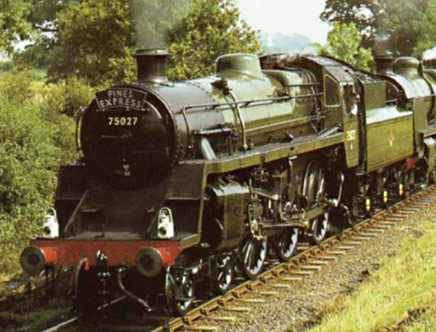)
The Standard 4 tender engines were designed as a modern branch-line engine, capable of hauling both freight and passenger services on the country’s secondary routes. Some, with larger tenders, were allocated to the Southern Region; however No. 75027 is a “foreigner”, although it did work over the Somerset and Dorset when allocated to the WR.
On its withdrawal from service it was one of the very last steam locos operating on British Railways. It was bought from BR by Charlie Pyne, one of our members, and donated by him to the railway. The locomotive appeared to be far larger than was necessary on the Bluebell of the late 1960s, but it soon proved its worth though as we entered the seventies. A relatively modern loco, capable of hauling heavier trains up our 1-in-75 gradients, it was very much appreciated. It remains to this day the ideal locomotive for many of our trains, powerful yet economical, attractive and easy to prepare and maintain.
It has been repainted for static display in the locomotive shed, and is one of several larger locomotives which should be overhauled in the next few years.
North London Railway Goods Tank
- Class: NLR Goods Engine
- Wheels: 0-6-0T
- Built: 1880
- Numbers Carried: NLR: 76, 116, LNWR: 2650, LMS: 7505, 27505, BR: 58850
- Last Overhaul Completed: 1984
- Last Operational: 1993
- Current Status: Static display (at Horsted Keynes), awaiting overhaul
- Owned By: Bluebell Railway
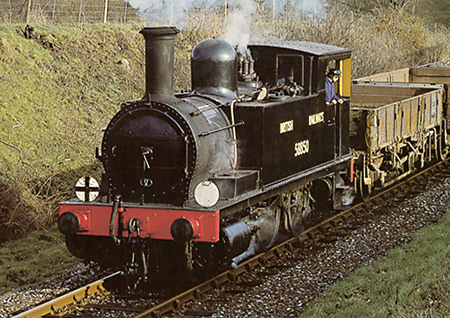)
This powerful goods locomotive was built for shunting in the docks served by the North London Railway, and for the goods traffic which emanated from the docks to be carried on the NLR’s 14-mile main line, probably frequently venturing out onto other companies’ lines with exchange traffic. The NLR subsequently became part of the LNWR and, at the grouping in 1923, the LMS. Several locos from this class became celebrities thanks to their use on the LMS’s very steeply graded Cromford and High Peak line in Derbyshire.
When this, the last one of the class, was withdrawn from traffic in 1960 it was kept at Derby until coming to the Bluebell in 1962. Used by contractors for the demolition of the line from East Grinstead to Ardingly, it has since been used in the rebuilding of the same line, on the Bluebell’s northwards extension. Requiring very major boiler work before it can again be steamed, in the interim it was placed on loan to other locations, and so both relieve space at Sheffield Park and act as an ambassador for the Bluebell in foreign part. Returned to the Bluebell some years ago, sadly the hope of a subsequent early overhaul has not materialised. Repainted into LMS livery as 27505 by the ‘Goods Division’ at Horsted Keynes in April 2023 (as seen in the second photo here), following earlier work by our 9F Club, it is planned to go on display in SteamWorks! at Sheffield Park.
LSWR Adams Radial Tank No. 488
- Class: 415
- Wheels: 4-4-2T
- Built: 1885
- Numbers Carried: 488, 0488, EKR 5, 3488, 30583
- Last Overhaul Completed: 1985
- Last Operational: 1990
- Current Status: Static display, a major overhaul is expected to commence in 2024
- Owned By: Bluebell Railway
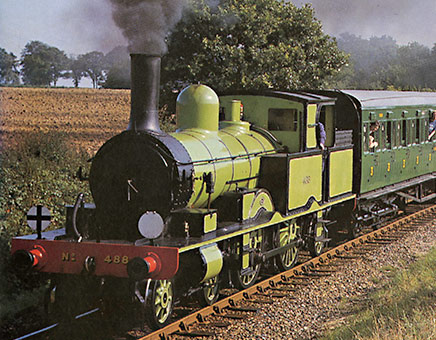)
Designed for the LSWR’s inner suburban network, these locomotives were displaced by electrification, and the entire class was scrapped by 1927 with the exception of two which were retained to operate the Lyme Regis branch, where sharp curvature made the use of anything other than this class of loco impossible. Many other classes were tried, but they either couldn’t cope with the heavily loaded holiday trains, or were too inflexible for the many curves. This particular loco though had been sold to the military during World War I, and in 1919 was sold on to the privately run East Kent Railway. In 1946 it was bought by the Southern and overhauled to provide relief for the other two Lyme Regis engines, and the three operated the branch until 1960.
No. 488 was chosen by the Bluebell since, out of the three, it was closest to original condition at the time of withdrawal, having an original Adams boiler. Following several spells in traffic over the next 30 years on the Bluebell it is the boiler which is now preventing this fine Victorian engine from steaming.
In 2019 it was repainted into the last livery it carried when running on the Lyme Regis Branch, as No. 30583 to match the two visiting ex-LSWR locomotives which were visiting for our Branch Line Weekend that year.
It will probably require a complete new boiler barrel before it can work again. It will enter “Atlantic House” at Sheffield Park soon for an assessment of the work required, whilst ‘Normandy’ is given a relatively quick overhaul ahead of it.
SR Maunsell U-class, No. 1618
- Class: U
- Wheels: 2-6-0
- Built: 1928 at Brighton
- Numbers Carried: A618, 1618, 31618
- Last Overhaul Completed: 1987
- Arrived On Bluebell Railway: 17 May 1977
- Current Status: Static display, awaiting overhaul
- Owned By: Maunsell Locomotive Society
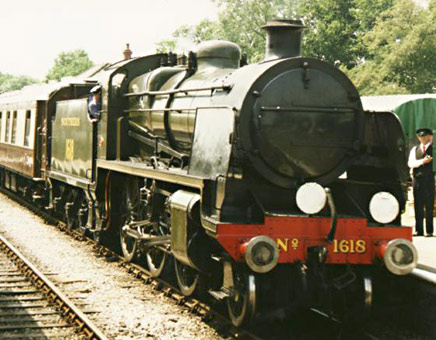)
The Sevenoaks accident of 1927 resulted in the rebuilding of the K-Class tank locomotives, known as the Rivers, as U-class tender engines, in which form they were much more successful, being very useful mixed traffic locomotives. 1618 was part of a batch which were to have been built as Rivers but the order was changed, and they came out as U-class locos. On withdrawal from Guildford in 1964 it went to Barry Scrapyard in South Wales, and was the second of the many locomotives to leave the yard for preservation.
Restored to working order, it steamed initially at the Kent & East Sussex Railway. However it was too heavy to be used on that line and so its owners relocated it to the Bluebell in 1977, and it has subsequently had two spells of activity. The U-class is an ideal locomotive for the size of trains we run on the Bluebell, and its sister locomotive, No. 1638, has been restored to working order, again by the Maunsell Locomotive Society, entering service for the first time in 42 years in 2006.
Because this locomotive’s tender was loaned to the Mid Hants Railway for a year, for use with another U-class which was painted in BR lined black livery, No. 1618 was repainted in the same scheme, since its existing paint was getting rather tired, and so this is how it is currently displayed. It is expected to be the next of the Maunsell Locomotive Society’s locomotives to be overhauled, once ‘Stowe’ is completed.
BR Standard 4MT Tank No. 80100
- Class: 4MT
- Designer: R.A. Riddles
- Wheels: 2-6-4T
- Built: 1955 at Brighton Works
- Arrived On Bluebell Railway: October 1978
- Current Status: Ex-Barry Scrapyard condition, stored under tarpaulin (at Horsted Keynes)
- Owned By: Bluebell Railway
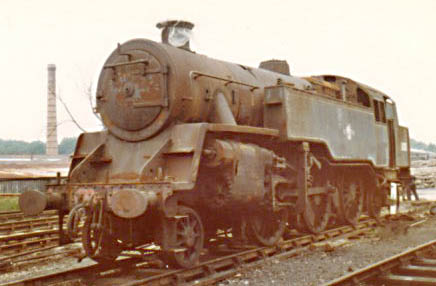)
One of two Standard 4 Tanks on the Bluebell, this particular locomotive was not a Southern-based engine in its BR days, working from Tilbury and later Shrewsbury until withdrawn for scrapping. As with 80151, it also survived at Barry Scrapyard long enough to be saved for preservation, arriving at the Bluebell in 1978.
It is retained because it belongs to the railway, and the strong links between the class and the line. However it is relegated to a long-term restoration objective, thanks to the presence on the line of the restored 80151.
Manning Wardle Contractor’s Locomotive ‘Sharpthorn’
- Class: Manning Wardle K
- Wheels: 0-6-0ST
- Built: 1877, Manning Wardle
- Numbers Carried: 641 (maker's number), No.4
- Last Operational: 1958
- Current Status: Static exhibit at Horsted Keynes
- Owned By: Bluebell Railway
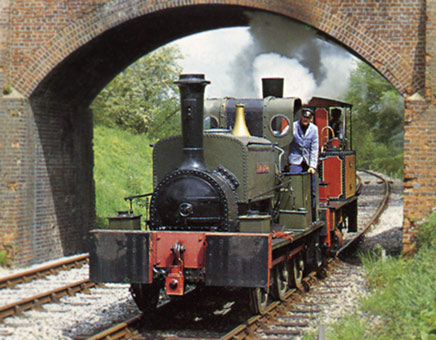)
This typical Victorian contractors’ loco is instantly recognisable as a Manning Wardle product. What makes this one special was that it was owned by Joseph Firbank, the contractor who built the Lewes and East Grinstead Railway, of which the Bluebell is a part. Delivered to West Hoathly (just north of our tunnel) it was employed throughout the construction of the line, taking its name (albeit mis-spelt) from the neighbouring village of Sharpthorne. From 1888 until 1982 it was the property of Samuel Williams & Sons and used to shunt the company’s coal dock at Dagenham until withdrawn from service in 1958. It was subsequently placed on loan to Bressingham Steam Museum, and moved to the Bluebell in 1981 for the line’s centenary celebrations in 1982, during which it took part in a locomotive cavalcade at Horsted Keynes.
The above photograph by Mike Esau shows it during this event. Since then it has remained at the Bluebell, having been purchased by the Bluebell from the receivers after Samuel Williams went out of business. Being considerably smaller than ‘Baxter’, it is not a large enough locomotive to haul passengers (although the Selsey Tramway used one of this class for their trains of three 4-wheelers, albeit without the steep gradients of the Bluebell line). As such it can be given no priority in our works schedule for overhaul. However a volunteer group on the railway have it in mind as a project for the future, with an initial aim of a cosmetic restoration and exhibition in Steam Works! at Sheffield Park. In the meantime it remains on static display, now at Horsted Keynes.
Bluebell-based locomotives on loan elsewhere
SECR Wainwright P-class, No. 178
- Class: P
- Wheels: 0-6-0T
- Built: 1910
- Numbers Carried: 178, A178, 1178, S1178, 31178
- Last Overhaul Completed: February 2010
- Last Operational: 4 October 2020
- Current Status: Stored under cover at The One:One Collection, Margate, awaiting overhaul
- Owned By: Bluebell Railway
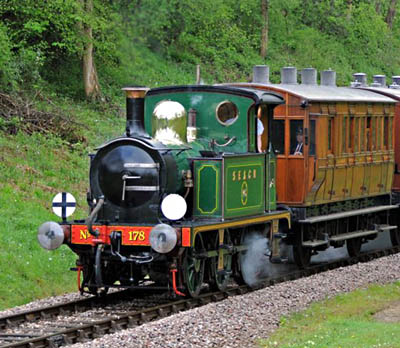)
The last of the four P-class tank locomotives to have steamed in preservation, 178 came to the Bluebell in 1969 after industrial service at Bowaters Paper Mill, where it carried the name “Pioneer II”.
Its best chance of restoration was seen to be outside the Bluebell Railway’s direct ownership, due to the railway already having two other Ps, and so it was sold to Southern Locomotives Ltd, who commenced its overhaul, at Sheffield Park. However, with the shift in emphasis of that group to become major providers of motive power to the Swanage Railway, it was decided more appropriate to transfer ownership of this ‘P’ class loco back to the Bluebell. This was achieved in mid 2006, thanks to funding made available by the Bluebell Railway Trust.
The overhaul was undertaken by the Loco Workshop working group, and the loco then run in full SECR lined green, after just a few weeks initially operating in its industrial guise as “Pioneer II”.
Sadly, having a crack in its cylinder, towards the end of its certificate the locomotive was capable of little more than light work. It was however ideal for light duties such as brake van rides, a role it fulfilled in 2017 on loan to the NRM in York. It will have replacement cylinders fitted at its next overhaul, once we see how those made for P-class No. 27 perform.
→ Find out more
→ Details of 2010 overhaul
→ The One:One Collection
GWR Earl/Dukedog No. 9017, ‘Earl of Berkeley’
- Class: Earl (later 90XX)
- Wheels: 4-4-0
- Built: 1938 (rebuild)
- Numbers Carried: 3217, 9017
- Last Overhaul Completed: 2003
- Last Operational: June 2011
- Current Status: Awaiting overhaul, on loan to the Museum at the Vale of Rheidol Railway in Aberystwyth
- Owned By: Bluebell Railway
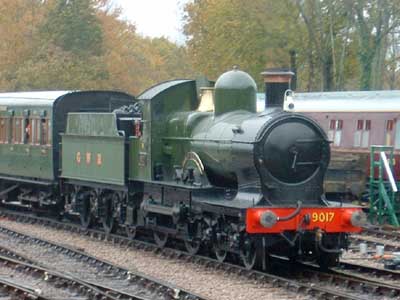)
Nicknamed “Dukedogs” since they were an amalgamation a Bulldog and a Duke, the parts of this loco are thus actually older than the “building” date suggests. The 1938 rebuild of 3217 used the frames from “Bulldog” No. 3425 (built 1906) and the boiler and cab from “Duke” class No. 3282 (originally named ‘Chepstow Castle’ and built in 1899).
A few of the class carried the names of earls, but 3217 did not receive its allocated name until preservation days. At the time the earls in question indicated to the GWR that, if their names were to be used, they would prefer their names on something a little more prestigious, and so they were transferred to new Castle class locomotives.
This class of locos was widely used on the Cambrian lines. At the time this loco was saved for preservation the Bluebell was the only line where it could run, and it has been in Sussex ever since, apart from a few years spent at the Great Western Society, Didcot.
The engine was re-painted in BR black in April 2009, as seen in Derek Hayward’s photo on the right. It came out of service in early June 2011 with a number of boiler and mechanical faults.
In February 2024 it moved on a 2-year loan, for display in the new Museum at the Vale of Rheidol Railway in Aberystwyth.

